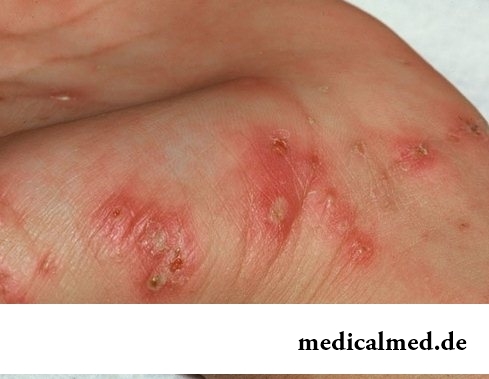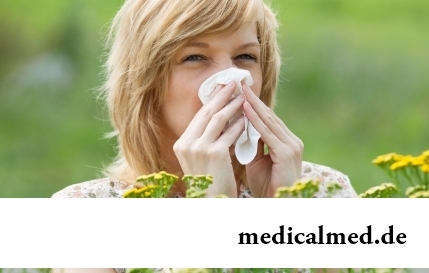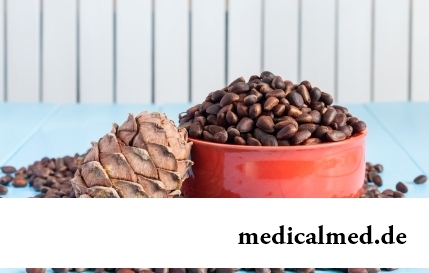





Mange
Short characteristic of a disease

Mange at the person is an infectious parasitic disease of skin. It is known to mankind since antique times, but long time doctors could not reveal a parasite and therefore denied the pathogenic nature of a disease, and connected emergence of skin defects with an emotional condition of patients. Today it is known that a mange at children and adults is caused by life activity of mites of Sarcoptes scabiei. They are eurysynusic in life, easily pass from the person to the person and cause various allergic reactions. Despite prevalence of activators, timely laboratory diagnosis of itch is complicated because of insufficient level of training of personnel of many dermatovenerologic institutions and lack of the necessary equipment.
Causative agent of itch
Mange is provoked by activity of itch mites of Sarcoptes scabiei. They have the tiny sizes and therefore are not found at usual survey with the naked eye. Getting on skin of the person, females of mites make in it an opening and begin "to bite" into thickness of a derma, leaving the characteristic scabby courses. Further the impregnated female will postpone the posterity in the made channels.
As a rule, a mange at the person is shown on palms, feet, wrists, elbows and generative organs (at men). Localization of activators on these sites is not accidental and is explained by two factors: small amount of hair and small thickness of epidermis. Besides, on feet and palms there are a lot of sweat glands. They emit sweat which fills the courses done by mites and creates the best conditions for development of posterity. Being born, larvae very quickly turn into adult individuals, get out to a surface of an integument and development repeats a life cycle. Let's notice also that if the person had an itch, itch symptoms constantly progress as, combing pruritic places, the patient promotes transmission of infection on healthy sites of skin.
Emergence of mites is fraught with the most different complications. The matter is that products of their life activity are initially incompatible with an organism of people and cause allergic reactions, promote emergence of the numerous centers of an inflammation. Especially strongly a mange exasperates patients in evening and night hours when parasites are most active.
Ways of infection
Itch source is always the person and household objects to which it contacted. Mites easily pass to healthy people during handshake or in direct skin contacts in public transport. Also the family disease outbreaks caused by the fact that usually members of one family use the general towels and other sanitary products are frequent. Besides, practically from 100% probability a mange will declare itself after sexual contacts with the sick partner.
Itch symptoms
The period of emergence of symptoms of itch fluctuates from several hours to 1,5-2 weeks. It is possible to carry to the main symptoms of itch:
- the itch – develops approximately in a month after infection with a mange, is reaction of an organism to waste products of mites. Unpleasant feelings amplify in evening and night time;
- emergence of the scabby courses – they have an appearance of a small whitish strip up to 1 cm long. Most often the channels laid by mites are located on a stomach, buttocks, feet, in axillary area, on palms and pleated an elbow bend;
- development of skin defects – crusts, dry cracks, bubbles.
Mange at children
At children a mange proceeds in much more severe form, than at adults. At the diagnosis a mange treatment of the child quite often means removal of parasites from all sites of an integument, including the person and a pilar part of the head. Besides, inflammatory processes affect also nails which become covered by cracks are thickened, become too friable. Other infections can join activity of parasites of itch that considerably complicates process of diagnosis and treatment.
Several words about diagnosis of itch. It is possible to find a female of a tick only by means of a microscope. For laboratory researches integument samples undertake, and scraping of the struck area becomes.
Treatment of itch

The course of treatment of itch is appointed on the basis of results of laboratory diagnosis. Achievement of the best results requires observance of the following conditions:
- at the diagnosis a mange treatment there undergo all members of the revealed center (a family, children's collective);
- during treatment of itch patients should not wash and change bed linen;
- clothes and other objects to which the patient contacted are exposed to disinfection;
- itch medicines are applied on all body, and not just on affected areas.
The modern medicine offers people rather wide choice of drugs. A mange at the person recovers by means of ointments, solutions and suspensions. Also folk remedies at treatment of itch are effective, but we will tell slightly below about them. As for the most widespread drugs, treat their number: benzyl benzoate, спрегаль, Unguentum sulfuratum. For the prevention of allergic reactions and inflammations antihistamines are used (Suprastinum, кларитин).
It is quite possible that symptoms of itch will be observed even after passing of a course of treatment. In this case it is necessary to repeat all procedures with use of stronger, efficient means.
Mange – treatment by folk remedies
Remember that before use of any national recipes it is necessary to consult with specialists who will tell you about nuances of these or those means and possible effects of their use. Let's list the most effective recipes:
- mix 1 tablespoon of turpentine with 2 tablespoons of butter. The received mix is applied on skin before going to bed;
- 1 tablespoon of a celandine mixes up with 4 tablespoons of vaseline. Means is intended for external use. All body, and not just affected areas is processed;
- birch tar is applied with a uniform layer on pruritic places, washed away in 3-4 hours by warm water.
The liver is the heaviest body in our body. Its average weight makes 1,5 kg.

Statistically, can only one of ten of our compatriots brag of a decent condition of an oral cavity. On среднестатистич...
Section: Articles about health
Musicotherapy – a treatment method which caused and causes a set of a controversy concerning its efficiency. However the facts are relentless: during the numerous researches curative impact of music on an organism was scientifically confirmed. Since then in a number of the countries a method...
Section: Articles about health
Producers of milk mixes for children assure: mixes are ideally balanced and adapted for needs of babies. If mother should raise artificially the kid owing to serious problems with health, to do nothing – it is necessary to feed with substitutes of milk. However pediatricians note that not seldom women without good reasons refuse feeding of the child a breast and pass to milk mixes. Common causes of such decision – the aspiration to leave quicker...
Section: Articles about health
(Xerostomia) many people consider feeling of a xerostomia small and easily removable inconvenience. This delusion...
Section: Articles about health
The pine is one of the most widespread plants of our woods. Its needles and pitch not without reason called by "gallipot" were since ancient times used for strengthening of protective forces of an organism, treatment of avitaminosis, anemia and many other diseases. In recent years wide п...
Section: Articles about health
Frosty air, fresh wind and easy snowball at most of Russians are associated with cheerfulness, health and cheerful entertainments on which our winter is so generous. But, unfortunately, cold season sometimes brings also troubles with health. It is not about seasonal colds and frostbites, and about those chronic illnesses which symptoms are shown preferential in the winter....
Section: Articles about health
Today about 30 diseases, sexually transmitted are known. To wide circulation of these illnesses extremely with...
Section: Articles about health
The body of the person almost for 60% consists of water. It is so important for normal functioning of an organism that loss of only one and a half percent of liquid already leads to the most unpleasant effects. The problems connected with deficit of water can overtake and...
Section: Articles about health
Sugar - the digestible refined product which is not of special value for an organism of the modern person. The use of sugar in food is based rather on the psychological dependence caused by desire to indulge itself with something tasty, and further and the biological, caused need of an organism for glucose as a result of big emissions of insulin in blood. Such circulation of insulin and glucose with continuous increase in portions of sugar is rather offensive and can become the reason for a narusha...
Section: Articles about health
The number of long-livers is very small. One person from 5 thousand lives up to age of 90 years, and the centenary boundary steps only about...
Section: Articles about health
Hemorrhoids – extremely widespread disease. Periodically arising inflammations and bleeding of hemorrhoidal nodes cause serious discomfort to nearly fifteen percent of adults. Meanwhile, having a clear idea of the aggravation reasons...
Section: Articles about health
Such trouble as the milkwoman's attack, at least once in life happened almost to each woman. Prevalence of a disease is explained by the fact that the causative agent of an illness belongs to the so-called opportunistic microflora living on mucous membranes of any human body and which is becoming more active only under favorable conditions. If you had curdled allocations from a vagina, the itch and burning in external genitals, or painful feelings disturb at sex...
Section: Articles about health
Sooner or later hair turn gray at all. Many people try to hide these changes, returning natural color of the hair with the help about...
Section: Articles about health
Dogrose – one of the most widespread adornment and medicinal plants growing practically in all territory of our country. To most of Russians it is a beautiful bush it is known, first of all, as a source of fruits, extremely vitamin-rich....
Section: Articles about health
Among a set of the perfumery and cosmetic goods which are released today the special group is made by the means containing antibacterial components. Such types of gels, shampoos, soaps, creams, lotions and other products are positioned by manufacturers as a panacea from all diseases caused by pathogenic microorganisms. The unlimited and uncontrolled use of similar means becomes result of trustfulness of the buyers hypnotized by persuasive advertizing sometimes. Many spetsial...
Section: Articles about health
For the person who daily since morning gathers for work it is very important to wake up vigorous and ready by day of work. On most...
Section: Articles about health
The main role in development of a peptic ulcer of a stomach and duodenum the bacterium Helikobakter plays pilor. Activity and the strengthened reproduction of this microorganism lead to weakening of protection of mucous membranes and their erosive damage. Manifestations not...
Section: Articles about health
Diapers for adults – individual one-time means of hygiene which in some situations is irreplaceable and from such situations any person is not insured. Though nobody perceives need of their use with enthusiasm, however without such means already problematic situation could be heavier....
Section: Articles about health
The immunity role in growth of the child is invaluable. The proteins-immunoglobulins produced by immune system preserve the child against diseases...
Section: Articles about health
The summer of this year in Russia was very ambiguous. Regions suffered from a merciless heat, from pouring rains, the hail from time to time dropped out, then there was again a heat which alternated with rainfall again. Many people suffer from such sharp changes of weather...
Section: Articles about health
Milk and products of its processing by right occupy one of the main places in a diet of the modern person. They contain proteins, necessary for normal life activity, fats, vitamins and microelements, and are an important part of various medical diets....
Section: Articles about health
Each person has easy indispositions which he transfers "standing", trying not to ask for medical care. Argu...
Section: Articles about health
There comes the season of issues. Many Russians already dream of outdoor recreation, trips, beautiful seaside beaches. At this time there is no wish to think of problems with health and other unpleasant things, however there are subjects which require attention. Summer...
Section: Articles about health
Zone hypostases under eyes - very widespread problem giving to people is a lot of inconvenience. Hypodermic fabric in these parts has very loose structure and almost does not contain collagenic fibers. Besides, the skin covering подглазья constantly is exposed to compression and stretching when the person blinks, blinks, etc. These features also create premises for emergence of the so-called bags which are giving to the face a tired and sickly look, and also visually adding increased...
Section: Articles about health
Doctors claim that the people not so familiar with a dorsodynia occur among adult Russians very seldom. At the same time подавляющ...
Section: Articles about health
The hysteromyoma is diagnosed more than at a third of women 35 years are more senior. This high-quality new growth which at early stages successfully resolves by means of medicines. It is necessary to resort to an operative measure only in those a case...
Section: Articles about health
Scientists have no unambiguous opinion on a proximate cause of emergence of a carcinoma cutaneum today. Only the factors promoting development of this illness are precisely established. Treat them: long impact on skin of ultraviolet rays, radiation exposure, thermal injuries, injuries of skin by aggressive chemicals (pitches, acids, alkalis, etc.), genetic predisposition (existence of malignant new growths of skin in the family anamnesis), at...
Section: Articles about health
